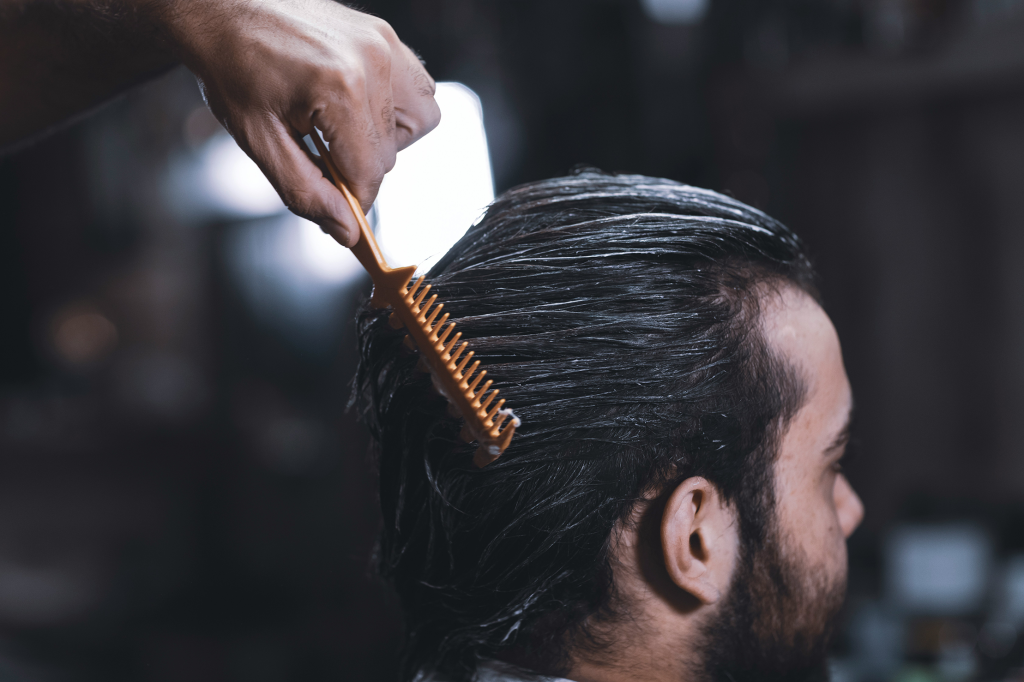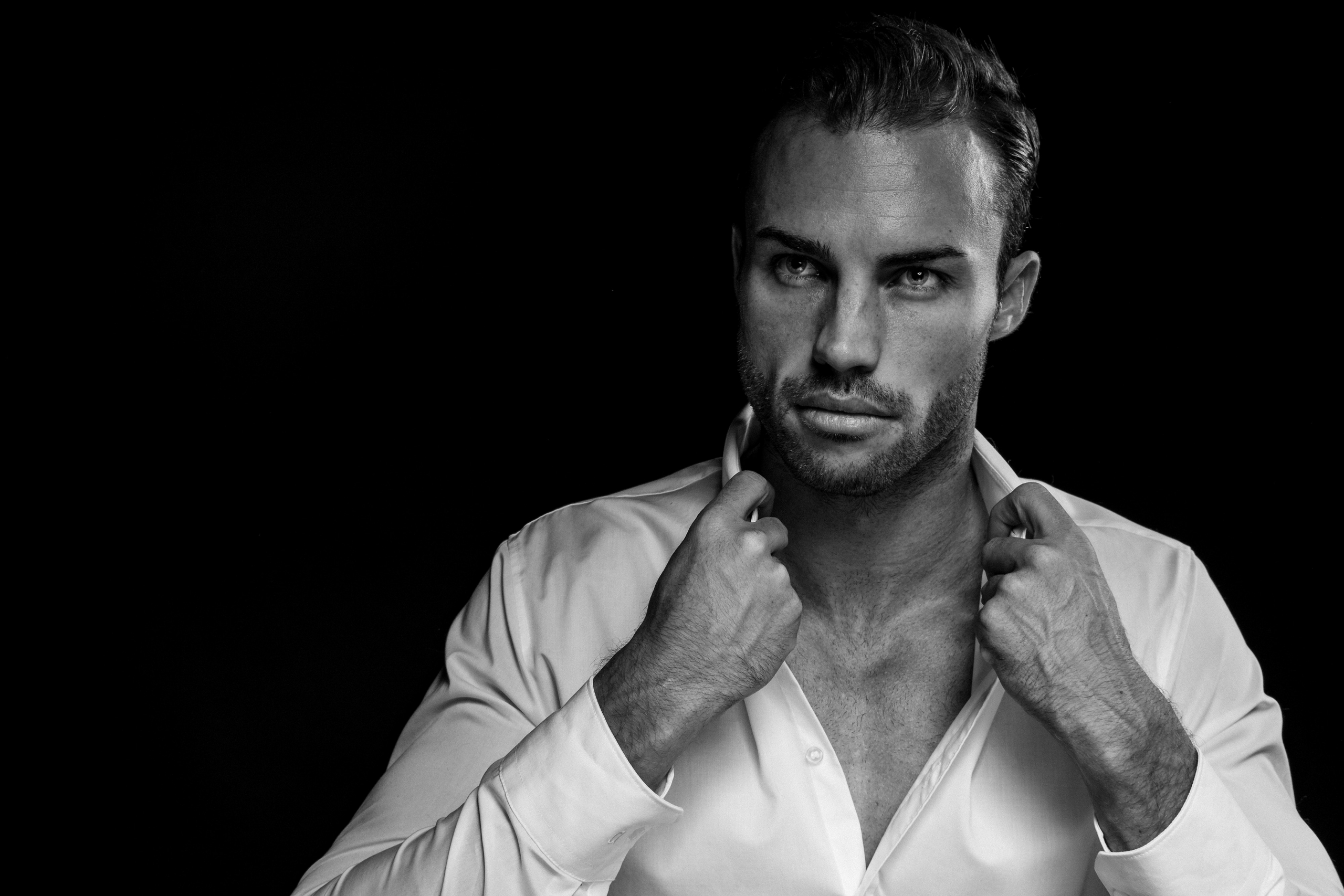Hair loss is a sensitive topic for many people. The search for solutions is leading more and more men to hair transplants, which have become a sought-after option worldwide. Procedures abroad are particularly popular – not least due to the often lower costs. However, what many don’t realize is that the success of a hair transplant depends not only on the operation itself but also on professional aftercare. This is where PRP therapy (Platelet-Rich Plasma) plays a crucial role. In my practice in Vienna, I regularly care for patients who specifically seek aftercare following a hair transplant to achieve optimal results.
Important Facts
- Treatment duration: 30 minutes
- Anesthesia: none
- Aftercare: None
- Result: Continuous stimulation of hair growth over weeks to months, multiple sessions necessary.
- Pain level: Low, only tiny punctures with very fine cannulas
- Social downtime: Immediate, rarely small crusts possible
- Price: 280€
Hair Transplantation: A Solution with a Long History
Even the ancient Egyptians documented attempts to treat hair loss and achieve greater hair density, and in the 1950s, the first modern hair transplants were performed. Today, hair transplants have become significantly gentler and more effective thanks to innovative techniques such as the FUE technique (Follicular Unit Extraction). In this process, hair follicles – usually from the back of the head – are removed and transplanted into the bald areas.
An increasing number of people are opting for treatments in countries like Turkey, where experienced clinics often offer more affordable prices. Such procedures are medically safe, but they require structured aftercare, which many patients fail to plan adequately upon their return to Austria. This is precisely where I want to support you in my practice in Vienna.

Why Post-Treatment is Crucial
The initial phase after a hair transplant is crucial for long-term success. Immediately after the operation, the new hair roots are particularly sensitive, and the scalp needs optimal conditions to heal. This is where PRP treatments come into play.
PRP, which stands for platelet-rich plasma, is derived from one’s own blood and contains highly concentrated growth factors that promote healing processes and strengthen hair roots. Studies show that PRP can accelerate the healing of transplanted hair follicles, promote blood circulation in the scalp, and support the growth of new hair.
PRP Post-Treatment: The Key to Success
Most of my patients report receiving their first PRP treatment immediately after their hair transplant abroad. However, the follow-up treatments – usually 3 to 5 sessions at intervals of about four weeks – often take place in their home country. Here, I can offer you my expertise in Vienna:
- Individual care: I discuss the progress after the hair transplant with each patient and create a tailored plan for PRP follow-up treatments.
- Experience and precision: Through years of experience with PRP therapy, I know what it takes to achieve optimal results.
- State-of-the-art technology: In my practice, I use the most modern PRP systems that ensure a high concentration of growth factors.
A major advantage of PRP treatment is that it is completely natural, as it is based on your body’s own substances. There are hardly any side effects, and patients can resume their daily activities immediately after the session.
What You Should Know
If you have undergone a hair transplant abroad, it’s important that you pay attention not only to the results of the operation but also to the aftercare. PRP treatments are a cost-effective and efficient procedure to ensure that your new hair roots thrive optimally and that you benefit from dense, strong hair in the long term.
Particularly important is the choice of a doctor with sufficient expertise, who is familiar with the subject and performs PRP treatments precisely and individually. In my practice in Vienna, I regularly care for patients who have exactly this requirement.
Your Partner for PRP Post-Treatments in Vienna
My practice offers you not only a pleasant atmosphere but also the assurance that you are in experienced hands. Whether you have questions about PRP treatments, need further recommendations for hair care, or want a long-term plan for more hair density – I am here to assist you.
Contact me for a non-binding consultation and find out how PRP can optimally support your hair transplant. Your path to full hair begins here in Vienna.

Why Men Experience Hair Loss
Hair loss in men is a complex issue with various causes. Besides stress or illnesses, it is often significantly determined by hormonal factors. A key role is played by the hormone Dihydrotestosterone (DHT), which is formed from testosterone by the enzyme 5α-reductase. While testosterone is generally known as the ‘male hormone’, DHT is actually the most effective androgen for hair roots. It has a central function in the development of male characteristics, but also significantly influences hair growth.
DHT affects hair follicles by shortening their growth phase and extending the resting phase. Especially in genetically predisposed individuals, this leads to hair growing back thinner and shorter until the follicles eventually cease to function entirely. This process, also known as androgenetic alopecia or hereditary hair loss, affects many men and often begins as early as their 20s or 30s.
Interestingly, not all cells react equally to DHT. While the hair in the back of the head is generally insensitive to the hormone, the follicles in the front and upper areas of the head are particularly susceptible. This is precisely why hair transplants usually take roots from the back of the head – these are resistant to DHT and remain stable even after transplantation.
The PRP Treatment Process: Explained Step by Step
PRP (Platelet-Rich Plasma) treatment is an innovative and gentle method to stimulate hair growth and effectively combat hair loss. But how exactly does such a treatment work? Here’s an overview of the individual steps – from preparation to aftercare.
1. Preparation: Laying the Foundation
At the beginning of the treatment, after a thorough medical consultation, a small amount of blood is first taken from a vein – similar to a routine blood draw. This blood serves as the basis for the platelet-rich plasma. It’s important to note that no special preparation is necessary on the patient’s part. Nevertheless, I recommend drinking plenty of water before the treatment to ensure optimal blood quality.
2. PRP Extraction: High-Tech in Action
The drawn blood is processed in a special centrifuge to separate the components from each other. The red blood cells and other components are separated from the platelet-rich plasma. This plasma is particularly valuable as it contains a high concentration of growth factors that promote the stimulation of hair follicles. The entire process takes only a few minutes and is performed directly in my practice.
3. Scalp Preparation: Precise Treatment
Before the actual treatment, the scalp is thoroughly disinfected to ensure a sterile working environment. Most patients find the treatment somewhat uncomfortable but tolerable, as the needles used are extremely fine.
4. PRP Injection: The Actual Treatment Step
The extracted blood plasma with concentrated platelets is injected directly into the affected areas of the scalp using fine needles. Areas such as the receding hairline are treated precisely to bring the growth factors directly to the hair roots. The injections stimulate blood circulation and stimulate the hair follicles. This step takes about 20 to 30 minutes, depending on the size of the area to be treated.
5. After the Treatment: No Downtime, but a Big Effect
After the PRP treatment, you can immediately resume your usual activities. There may be slight redness or minimal swelling, which subsides after a few hours. It is recommended not to wash the scalp for the first 24 hours after treatment and to avoid sports or sauna for one to two days to optimize the effect.
6. Regular Treatments: The Key to Success
For optimal results, PRP treatment is usually performed in multiple sessions. A typical treatment cycle includes three to five sessions spaced four to six weeks apart. After that, often one to two refresher treatments per year are sufficient to maintain the effect long-term.
PRP treatment impresses with its natural and effective mode of action and offers men struggling with hair loss a promising solution. It is particularly ideal as a complement after hair transplantation to promote the growth of transplanted hair and improve the overall appearance.
Frequently Asked Questions about PRP Treatment
Is PRP treatment painful?
Most patients find the treatment to be well-tolerable. Due to the use of very fine needles, the pain is minimal. Some describe the sensation as a slight pricking or tingling.
How long does a PRP treatment take?
A typical session lasts about 30 to 45 minutes. The majority of this time is spent on blood collection, centrifugation, and the actual injection of the PRP.
Are there any side effects?
PRP treatment is considered very safe as only the body’s own material is used. After the treatment, slight redness, swelling, or minimal bruising may occur, which subsides after a few hours or days. Allergic reactions are practically impossible since no foreign substances are injected.
When will I see first results?
Patience is key: First improvements, such as a stop in hair loss, can become visible to those affected after one to two months. Hair growth usually becomes clearly noticeable after three to six months. Patients who adhere to the recommended treatment cycles achieve the best results.
How many sessions are necessary?
A typical treatment plan includes, after a comprehensive consultation, three to five sessions at intervals of four to six weeks. Afterward, refresher treatments every six to twelve months are sufficient to maintain the results.
Can PRP also help with genetically caused hair loss?
Yes, autologous blood therapy can also help with genetically caused hair loss (androgenetic alopecia). It improves blood circulation to the follicles and stimulates hair growth. However, PRP is not a replacement for medications like Minoxidil, but a valuable complement.
Is PRP also suitable for women?
Absolutely! PRP is an effective method for both men and women suffering from hair loss. In women, it is often used for diffuse hair loss or hormone-related hair loss.
Are there any contraindications?
Yes, there are a few exclusion criteria. Patients with active infections, certain autoimmune diseases, cancer, or blood clotting disorders should avoid PRP treatment. The treatment is also not recommended during pregnancy or breastfeeding.
How does PRP differ from other hair loss treatments?
PRP is a natural method based on the body’s own material and does not use chemicals or medications. Compared to topical or medicinal therapies, PRP has no systemic side effects and is ideal for patients seeking a gentle but effective solution due to these properties.
What should I consider before the treatment?
Ten days before the treatment, you should avoid taking pain medications such as aspirin, ibuprofen, diclofenac, or similar preparations, as these can reduce the concentration of platelets in the plasma. It is also important that any cortisone therapy has been completed at least two weeks prior.
If you have any further questions, I am happy to be at your disposal personally in my practice. Together we will find the best solution for your individual needs!


Why is PRP so safe?
PRP therapy is considered extremely safe because it is based on the body’s own material. The blood plasma used in the treatment comes directly from the patient, virtually eliminating the risk of allergic reactions or intolerances. Additionally, no chemical additives or foreign substances are added during the process, making the method even more natural. Another safety aspect is that PRP is prepared under sterile conditions and the highest hygienic standards. Since no surgical interventions are necessary and only fine needles are used, the treatment is minimally invasive and associated with a low risk of infection. This makes PRP not only effective but also well-tolerated by almost every patient – regardless of age or skin type.
Growth Factors in Platelet Rich Plasma - How They Help Hair Growth
The secret of PRP treatment lies in the growth factors contained in the blood platelets (thrombocytes). These growth factors, including the platelet-derived growth factor (PDGF), the vascular endothelial growth factor (VEGF), the insulin-like growth factor (IGF-1), and the epidermal growth factor (EGF), play a key role in cell regeneration and tissue repair. In the context of hair growth, they promote the health and blood circulation of the scalp and stimulate follicle activity.
The improved blood circulation allows more nutrients and oxygen to reach the hair roots, optimizing the environment for new hair growth. At the same time, the growth factors also stimulate the proportion of dormant follicles and promote the extension of the hair’s growth phase (anagen phase). This combination of effects can help reduce hair loss and make hair grow thicker, healthier, and stronger. The targeted application of these body’s own substances makes PRP treatment a particularly natural and effective method against hair loss.
Diverse Applications of PRP in Medicine
Platelet-rich plasma is not only an effective therapy as a hair loss treatment; blood plasma treatment has also established itself in other fields of medicine. Particularly in orthopedics, blood plasma is frequently used, for example, to support the healing of sports injuries such as tendonitis, ligament injuries, or arthritis. Here, the growth factors promote the regeneration of damaged tissues and alleviate inflammation. Blood plasma is also popular in aesthetic medicine: In the form of the so-called “vampire facelift”, it is used to tighten the skin, stimulate collagen production, and promote a fresh complexion. Furthermore, PRP is used in dentistry, for instance in healing after implantations or tooth extractions, as well as in wound treatment, where it can close chronic wounds faster. This wide range of applications underscores the potential of autologous blood therapy as a body’s own and natural treatment option aimed at healing and regeneration.
How Hair Transplantation Works
Hair transplantation is a surgical procedure in which follicles are removed from a donor area – usually from the back or sides of the head, less commonly from the beard area – and transplanted into the bald or thinning areas. There are two common techniques for surgical treatment against hair loss: the FUE technique (Follicular Unit Extraction) and Follicular Unit Transplantation. With the FUE technique, individual follicles are precisely extracted, while in the Follicular Unit Transplantation method, a narrow strip of skin is removed and then divided into individual follicles (however, this type of operation is becoming increasingly rare). The extracted follicles are carefully prepared and then implanted into tiny incisions or channels in the recipient region. This process requires not only precision but also an aesthetic sense to ensure a natural hair appearance. The procedure is usually performed under local anesthesia, and patients can typically resume their normal daily activities the next day. After a hair transplantation, follow-up treatment with PRP is particularly beneficial to promote the growth of the transplanted hair and optimize the treatment results.
